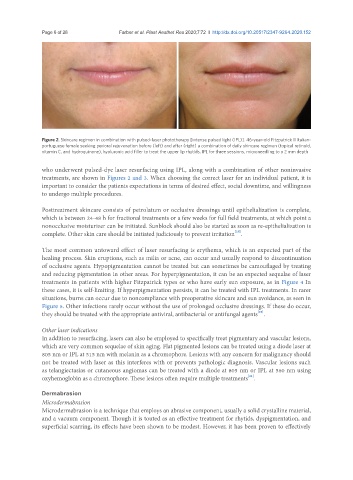Page 856 - Read Online
P. 856
Page 6 of 28 Farber et al. Plast Aesthet Res 2020;7:72 I http://dx.doi.org/10.20517/2347-9264.2020.152
Figure 2. Skincare regimen in combination with pulsed-laser phototherapy [intense pulsed light (IPL)]. 46-year-old Fitzpatrick II Italian-
portuguese female seeking perioral rejuvenation before (left) and after (right) a combination of daily skincare regimen (topical retinoid,
vitamin C, and hydroquinone), hyaluronic acid filler to treat the upper lip rhytids, IPL for three sessions, microneedling to a 2 mm depth
who underwent pulsed-dye laser resurfacing using IPL, along with a combination of other noninvasive
treatments, are shown in Figures 2 and 3. When choosing the correct laser for an individual patient, it is
important to consider the patients expectations in terms of desired effect, social downtime, and willingness
to undergo multiple procedures.
Posttreatment skincare consists of petrolatum or occlusive dressings until epithelialization is complete,
which is between 24-48 h for fractional treatments or a few weeks for full field treatments, at which point a
nonocclusive moisturizer can be initiated. Sunblock should also be started as soon as re-epithelialization is
[25]
complete. Other skin care should be initiated judiciously to prevent irritation .
The most common untoward effect of laser resurfacing is erythema, which is an expected part of the
healing process. Skin eruptions, such as milia or acne, can occur and usually respond to discontinuation
of occlusive agents. Hypopigmentation cannot be treated but can sometimes be camouflaged by treating
and reducing pigmentation in other areas. For hyperpigmentation, it can be an expected sequalae of laser
treatments in patients with higher Fitzpatrick types or who have early sun exposure, as in Figure 4 In
these cases, it is self-limiting. If hyperpigmentation persists, it can be treated with IPL treatments. In rarer
situations, burns can occur due to noncompliance with preoperative skincare and sun avoidance, as seen in
Figure 5. Other infections rarely occur without the use of prolonged occlusive dressings. If these do occur,
[25]
they should be treated with the appropriate antiviral, antibacterial or antifungal agents .
Other laser indications
In addition to resurfacing, lasers can also be employed to specifically treat pigmentary and vascular lesions,
which are very common sequelae of skin aging. Flat pigmented lesions can be treated using a diode laser at
805 nm or IPL at 515 nm with melanin as a chromophore. Lesions with any concern for malignancy should
not be treated with laser as this interferes with or prevents pathologic diagnosis. Vascular lesions such
as telangiectasias or cutaneous angiomas can be treated with a diode at 805 nm or IPL at 560 nm using
[21]
oxyhemoglobin as a chromophore. These lesions often require multiple treatments .
Dermabrasion
Microdermabrasion
Microdermabrasion is a technique that employs an abrasive component, usually a solid crystalline material,
and a vacuum component. Though it is touted as an effective treatment for rhytids, dyspigmentation, and
superficial scarring, its effects have been shown to be modest. However, it has been proven to effectively

